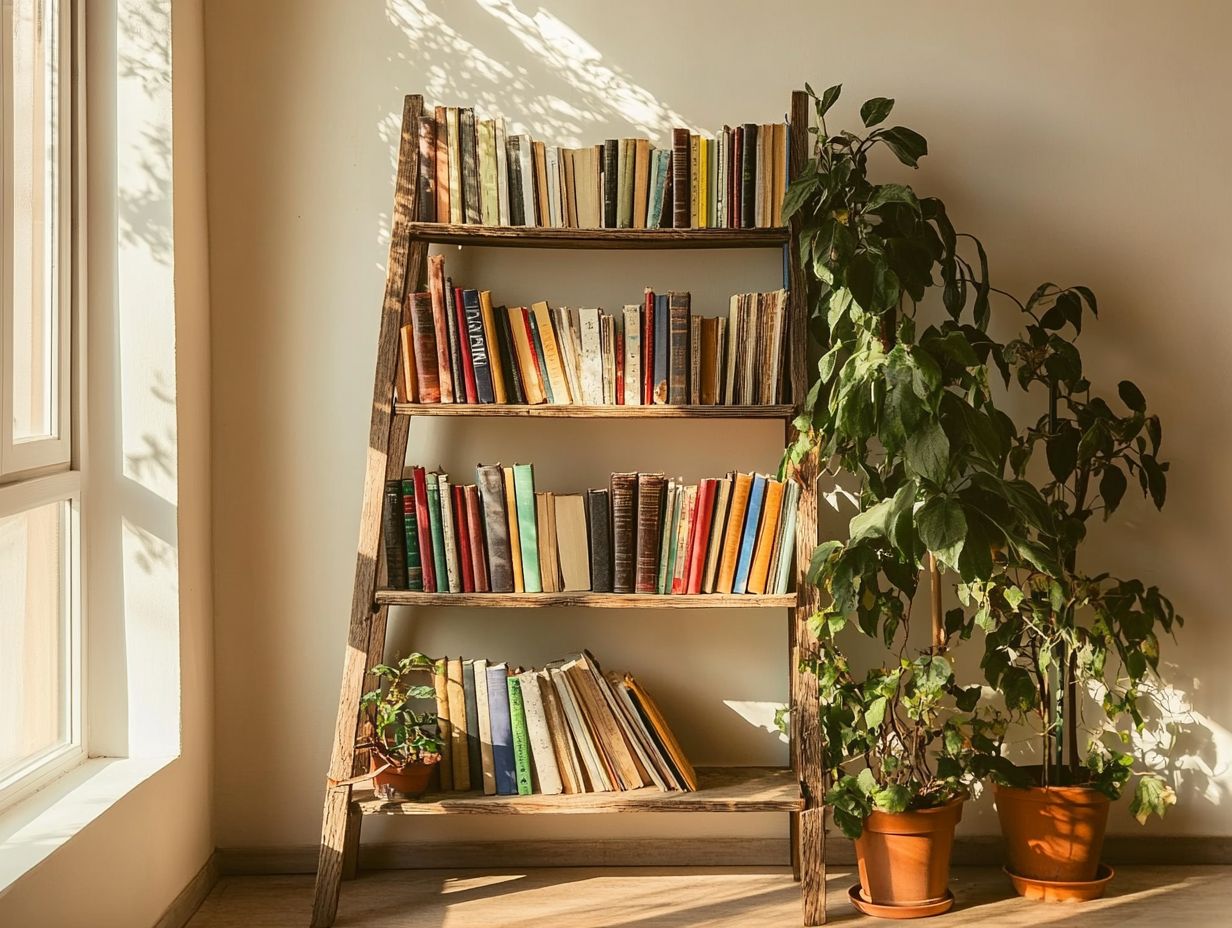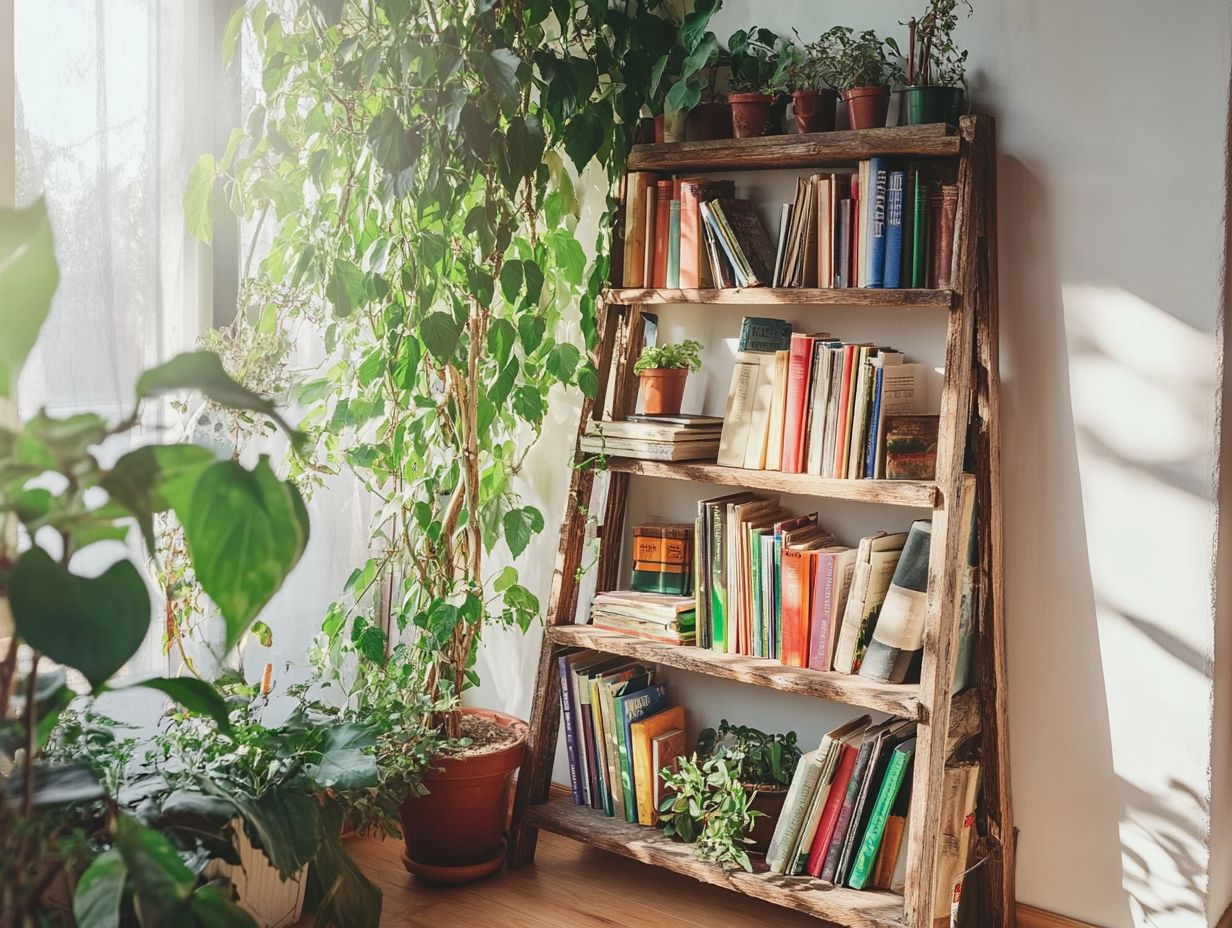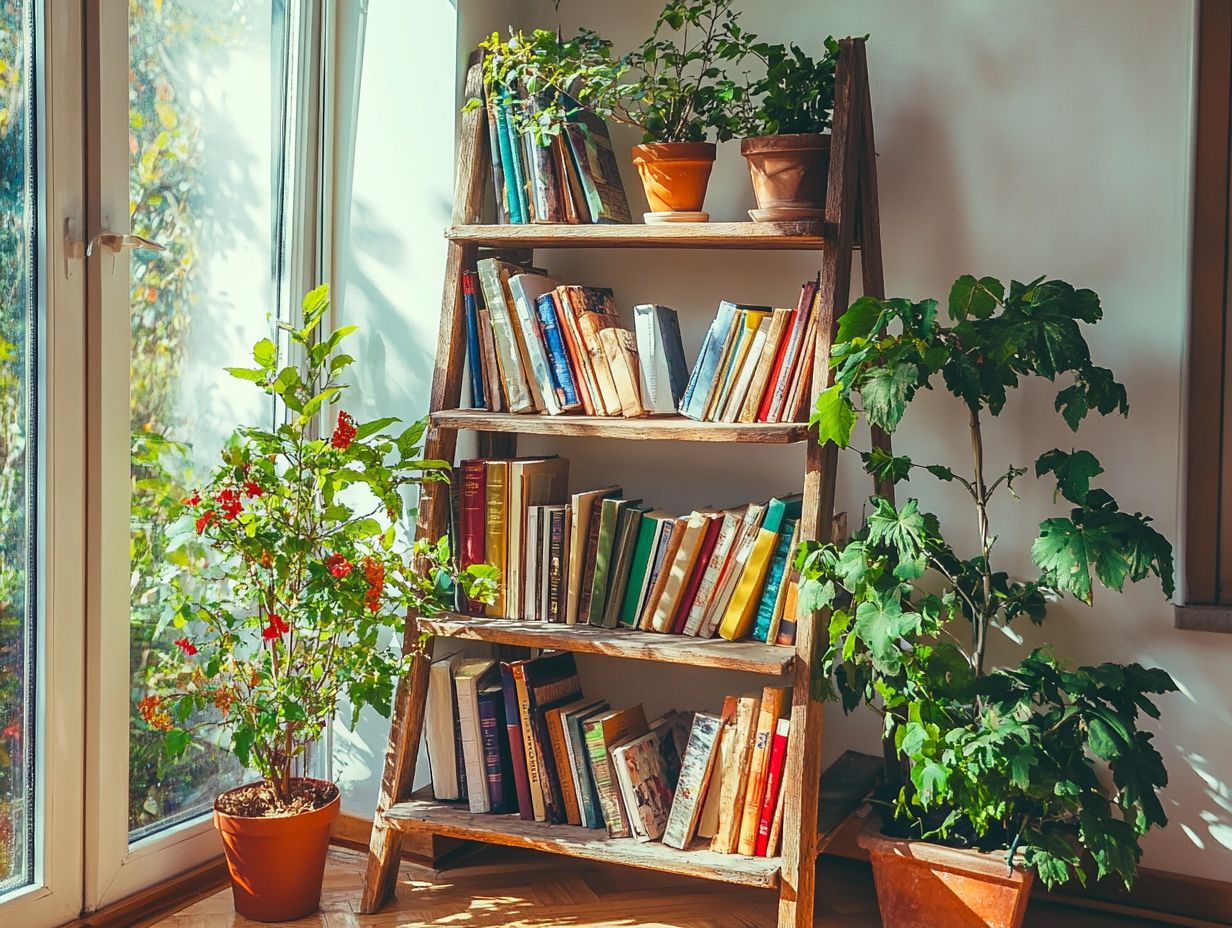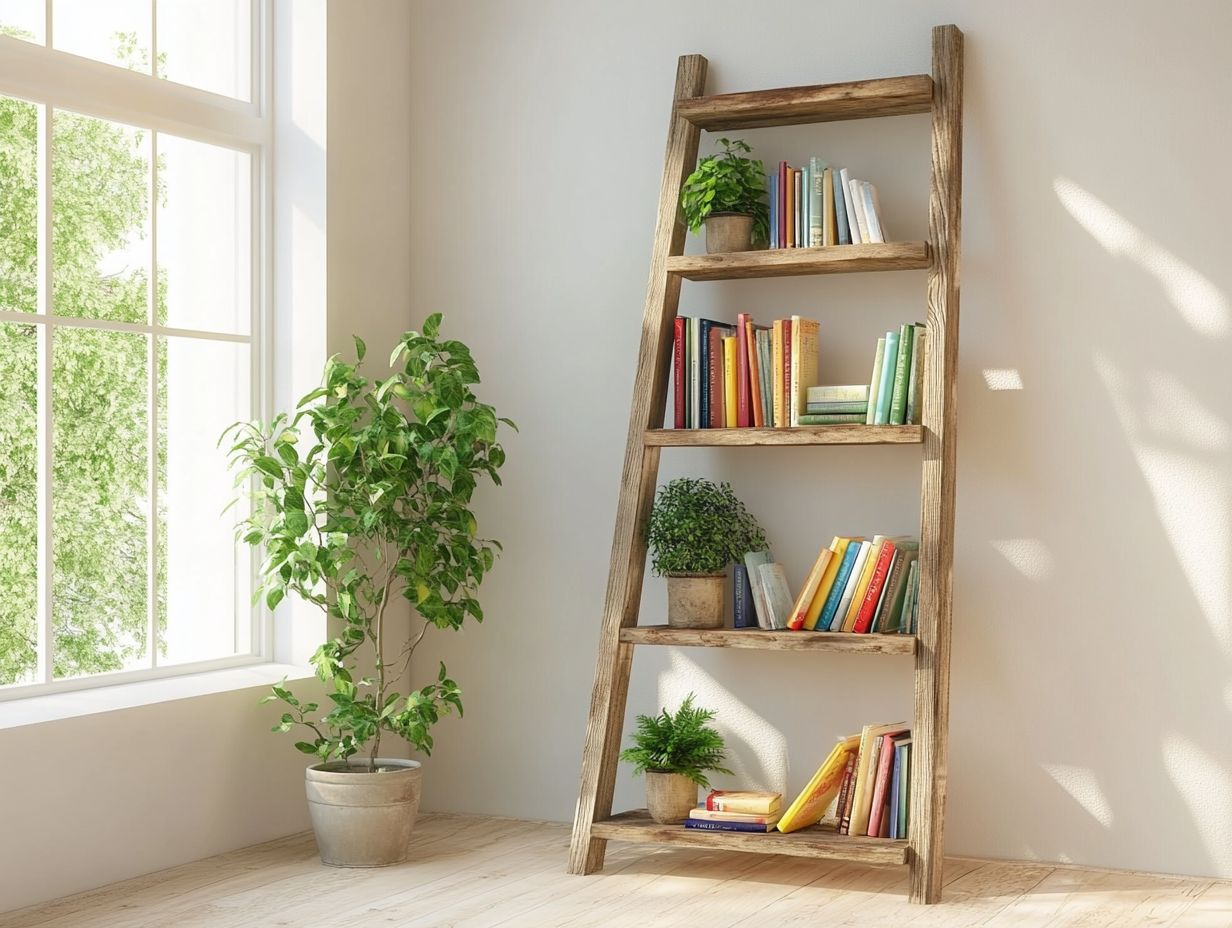DIY projects provide an excellent opportunity to enhance one’s home while fostering creativity. Among the essential tools for these endeavors, ladders are particularly notable for their efficiency and versatility.
Utilizing a ladder can significantly expand the range of possibilities for those seeking to save money or create distinctive decor. This guide examines various DIY ladder project ideas, including stylish ladder shelves and functional plant stands.
Additionally, it offers guidance on selecting the appropriate ladder and essential safety tips to ensure that these projects are both enjoyable and successful.
What is DIY and Why Use Ladders?

DIY, or Do It Yourself, represents an enableing approach to home improvement that encourages individuals to engage in creative projects that enhance their living spaces while also being cost-effective. A particularly versatile tool within the DIY toolkit is the ladder, which can be repurposed into unique designs that serve functional purposes while contributing to aesthetically pleasing home decor.
The potential applications are vast, ranging from wooden ladders transformed into shelving units to innovative projects that utilize ladders as distinctive display pieces.
Utilizing ladders in home decor not only fosters personal expression but also promotes sustainable practices through creative reuse. For example, vintage ladders can be elegantly positioned as plant stands, thereby creating a vibrant vertical garden, while smaller or step ladders can be converted into cozy reading nooks with the addition of cushions and throws.
Enhancing a simple ladder with paint or decorative elements can elevate it into a stylish coat rack or serve as an eye-catching focal point in a hallway. Embracing DIY ladder projects encourages innovation and problem-solving, allowing individuals to customize their environments in ways that reflect their unique personalities and styles.
Benefits of Using Ladders for Home Projects
Incorporating ladders into home projects provides a multitude of benefits that enhance both efficiency and versatility, rendering them essential tools for various do-it-yourself endeavors.
Ladders can be repurposed into multifunctional furniture, such as ladder shelving and storage solutions, which optimize vertical space and promote home organization while introducing a distinctive rustic decor element to interior environments.
Whether utilized for convenient access to elevated areas or for creative repurposing in innovative home decor projects, ladders offer numerous opportunities for individuals with a penchant for crafting and design.
Efficiency and Versatility
The efficiency and versatility of ladders render them an essential element in innovative home improvement projects, enabling DIY enthusiasts to achieve new heights—both literally and figuratively. Equipped with appropriate tools for DIY, including ladder DIY kits, individuals can construct multifunctional furniture pieces that are not only practical but also aesthetically pleasing, thereby enhancing the overall functionality and appearance of their homes.
These kits typically comprise a variety of ladder types, such as step ladders, extension ladders, and multi-position ladders, each specifically designed for distinct tasks. For example, a step ladder facilitates activities like painting walls or changing light fixtures, while an extension ladder is ideal for accessing elevated areas such as roofs or gutters. The potential applications are extensive—one can envision repurposing a ladder as a bookshelf or utilizing it as a decorative feature in a garden.
The inherent sturdiness and design versatility of ladders not only simplify the crafting process but also foster creativity, ensuring that each project embodies the homeowner’s unique style.
Cost Savings

Utilizing ladders in home projects can lead to significant cost savings, making them an excellent option for budget-conscious renovations and improvements. By upcycling old or unused ladders, individuals can create stylish and functional decor items without the need for costly materials or furniture. Additionally, the abundance of DIY tutorials available online further enhances this process.
These versatile structures can be repurposed into unique shelving units, garden planters, or even innovative light fixtures, allowing individuals to showcase their personal style while adhering to a budget. For instance, an old wooden ladder can be transformed into a rustic bookshelf, adding character to any room without incurring excessive expenses.
By exploring various DIY initiatives, individuals can not only save money but also express their creativity, resulting in personalized spaces that reflect their unique tastes. With inspiration readily accessible through numerous online platforms, the potential for upcycling projects is virtually limitless, encouraging a broader audience to embark on cost-effective home improvement endeavors.
DIY Ladder Project Ideas
The realm of DIY ladder project ideas presents a wealth of inspiration, featuring a diverse array of ladder crafts that convert ordinary wooden ladders into aesthetically pleasing decor and functional furniture.
Projects such as ladder shelving units for displaying books and home accessories, as well as elegantly designed ladder plant stands that enhance garden spaces, exemplify how these innovative designs not only elevate the home environment but also highlight individual creativity in DIY endeavors.
Ladder Shelves
Ladder shelves have gained popularity among DIY enthusiasts as an innovative solution for home organization, effectively combining rustic decor with practical functionality. These ladder shelving units can be constructed using repurposed ladders, making them an environmentally sustainable option that enhances the aesthetic appeal of any room while providing ample storage opportunities.
The process typically begins with the selection of a sturdy wooden ladder, preferably one with a weathered finish that aligns with rustic design principles. Following the removal of any existing paint or varnish, the ladder should be sanded to achieve a smooth surface. Once adequately prepared, shelving boards—crafted from reclaimed wood or plywood—are cut to fit securely between the rungs.
To ensure durability, these boards should be fastened securely using screws or brackets. These versatile units not only function as decorative elements but also provide practical spaces for storing books, plants, and decorative items, thereby contributing both charm and organization to living areas, home offices, or kitchens.
Ladder Plant Stand

A ladder plant stand serves as an innovative method to express one’s passion for gardening while enhancing home decor with a touch of creativity. By repurposing an old ladder into a functional plant stand, individuals can creatively reuse materials and develop an appealing display for their favorite plants, seamlessly integrating nature with unique ladder crafts.
This approach not only proves to be cost-effective but also allows for a personalized touch that reflects individual style. Whether one opts to retain the ladder’s rustic appearance or apply a fresh coat of paint, the possibilities are virtually limitless. Gardening enthusiasts can strategically position small to medium-sized pots on each rung, varying the heights for visual interest, while cascading plants can elegantly drape over the edges.
A ladder plant stand can enrich any room, contributing a splash of greenery to living spaces or making a striking statement on patios or balconies. Additionally, accessorizing with decorative stones or fairy lights can enhance the overall aesthetic, creating an inviting atmosphere that celebrates the beauty of nature.
Ladder Towel Rack
Transforming a ladder into a towel rack represents an innovative DIY project that combines practicality with aesthetic appeal, enhancing the charm of your bathroom decor. A ladder towel rack serves not only as a functional solution for hanging towels but also as a decorative element that can elevate the overall aesthetic of the space.
This project commences with the selection of appropriate materials; reclaimed wood imparts character, while new materials may offer enhanced durability. Customizing the design allows for various height and width configurations, making it adaptable to any bathroom layout. Consideration should be given to painting or staining the wood to ensure it complements the existing decor.
In terms of installation, it is advisable to secure the ladder to a wall for stability, ensuring it is positioned at a convenient height for easy access to towels. This distinctive piece not only organizes bath essentials but also introduces a rustic charm that enriches the bathroom ambiance, rendering it both a functional and stylish addition.
Ladder Bookshelf
A ladder bookshelf represents an excellent opportunity to combine innovative storage solutions with sophisticated home decor, making it ideal for displaying both a collection of books and decorative items. By utilizing a ladder as the foundation for the bookshelf, one can create a distinctive design that enhances the home library while also serving as a point of interest for conversation.
These versatile pieces integrate seamlessly into various environments, transforming previously underutilized corners into functional displays. When selecting the appropriate ladder, it is important to consider the style; wooden ladders provide a sense of warmth, while metal options offer a more contemporary aesthetic.
For the arrangement of books and decorative elements, it is advisable to employ a combination of horizontal and vertical placements. Larger books can effectively serve as platforms for smaller decorative items, thereby adding depth and visual interest to the overall arrangement. Ladder bookshelves not only optimize vertical space but also encourage creativity in the presentation of personal treasures, making them a practical and visually appealing addition to any room.
Ladder Desk

Creating a ladder desk represents an innovative approach to incorporating multifunctional furniture into a home office, offering a stylish workspace that maximizes space while enhancing productivity. This DIY project is ideal for individuals seeking straightforward home improvements that seamlessly blend functionality with aesthetic appeal, allowing for a customized touch in their working environment.
When designing a ladder desk, it is essential to consider its size to ensure that it fits comfortably within the designated area without overwhelming the room. Selecting the appropriate materials is equally important; sturdy wood or metal can provide durability while contributing to a modern or rustic aesthetic.
Moreover, it is advisable to think about workspace organization—integrating shelving or hooks can help maintain supplies in an orderly fashion and within reach, thereby reducing clutter. A well-constructed ladder desk can serve multiple purposes, functioning as a display for decorative items or as a versatile surface for both work and leisure activities, making it a valuable addition to any home office.
How to Choose the Right Ladder for Your Project
Selecting the appropriate ladder for a DIY project is essential for ensuring both safety and effectiveness, as various projects require specific types and features of ladders.
When choosing a ladder, it is important to consider factors such as height, weight capacity, and intended use, along with safety features that can help mitigate the risk of accidents during home improvement activities.
Factors to Consider
When selecting a ladder, it is essential to understand the different types available and their respective safety features to ensure that the ladder effectively meets the requirements of your project. Factors such as weight capacity and height must be carefully assessed to guarantee both safety and functionality during your DIY endeavors.
Various ladder types are available, including extension ladders, step ladders, and multi-use ladders, each designed for specific applications. Extension ladders provide access to elevated areas, making them suitable for roof work or high painting tasks, while step ladders offer stability for indoor tasks such as reaching high shelves or hanging decorations.
Safety features, including slip-resistant rungs, locking mechanisms, and wide bases, enhance user protection during operation. It is crucial to consider the ladder’s weight capacity to accommodate both the user and any tools that may be carried.
By evaluating the specific requirements of your project, including height and weight demands, you can select the most appropriate ladder type, thereby ensuring both effectiveness and safety in your tasks.
Tips for Safe and Successful DIY Ladder Projects
Prioritizing safety is of utmost importance when engaging in DIY ladder projects, as improper ladder usage can result in accidents and injuries. To achieve successful outcomes, it is essential to adhere to best practices for ladder safety.
This includes ensuring proper setup, maintaining appropriate weight distribution, and sustaining focus while working at height.
Proper Ladder Usage
Understanding the proper usage of ladders is essential for ensuring safety and enhancing the efficiency of DIY projects. Implementing safe practices, such as maintaining three points of contact and avoiding overreaching, can significantly diminish the risk of accidents when working with ladders.
Plus these foundational techniques, it is critical to recognize the significance of selecting the appropriate type of ladder for each specific task. For example, utilizing extension ladders for accessing higher points or step ladders for stability can lead to notable improvements in safety and effectiveness.
Before use, it is imperative to inspect the ladder for any structural damage, as this precaution is vital for preventing potential mishaps. Properly positioning the ladder on level ground and securing it adequately will enhance its stability, allowing for more focused and efficient work.
By incorporating these practices, individuals can establish a safer working environment that not only mitigates risk but also promotes improved productivity during any project.
Precautions and Safety Measures
Implementing effective precautions and safety measures is essential for mitigating risks associated with DIY ladder projects, thereby ensuring a safe working environment. By adhering to established guidelines—such as inspecting the ladder prior to use and ensuring a stable setup—individuals can significantly reduce potential hazards and concentrate on their creative endeavors.
It is imperative to select the appropriate ladder for the specific task, taking into account both height and weight capacity to prevent overloading. The ladder should always be positioned on a flat surface, and the use of stabilizers is recommended for added security.
When ascending or descending, it is important to maintain three points of contact, which means that either two hands and one foot or two feet and one hand must remain in contact with the ladder at all times.
Fostering a culture of safety is crucial; all individuals involved in the project should be educated about these practices, thereby creating an environment in which safety is prioritized. Adhering to these best practices not only protects individuals but also encourages others to adopt safer behaviors.


